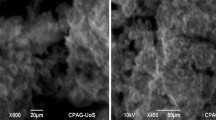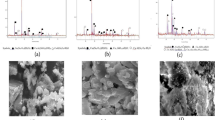Abstract
In this study, the use of colemanite (C) and colemanite concentrator wastes (CW) in self-compacting concrete (SCC) mixtures was investigated. It is known that additives containing boron minerals have a retarding effect on cement hydration. From this viewpoint, boron minerals containing various concentrations of C and CW were used and their effects on fresh concrete properties were investigated. In this context, single point tests and rheometer tests were applied. In addition, the setting times and unit weights of the samples were measured, and the compressive strengths at 7, 28 and 90 days were determined. The hydration developments of the samples were investigated by TGA and SEM investigations. The use of C and CW generally negatively affected the compressive strength, while the use of 1% C provided a slightly higher strength than the reference at the end of 90 days. The degree of hydration data obtained using TGA and the microstructural investigations via SEM supported these results. As a result of fresh state tests, it has been observed that the use of C improves and maintains the fresh properties and rheological parameters of self-compacting concrete, while the use of CW generally had the opposite effect. It is thought that this is due to the negative effect of the clay minerals in CW's composition and the fact that the B2O3 amount in its content is less when compared to the C.



















Similar content being viewed by others
Data availability statement
All data, models, and code generated or used during the study appear in the article.
References
Saeedian A, Dehestani M, Asadollahi S, Vaseghi Amiri J. Effect of specimen size on the compressive behavior of self-consolidating concrete containing polypropylene fibers. J Mater Civ Eng. 2017;29:04017208. https://doi.org/10.1061/(ASCE)MT.1943-5533.0002067.
Okamura H, Ouchi M (1999) Self-compacting concrete. Development, present use and future. In: First int. RILEM symp. self-compacting concr., RILEM Publications S.A.R.L, 1999, p 3–14
Shi C, Khayat KH, Xie Y (2005) Design and application of self-compacting lightweight concrete. İn: 1st Int. symp. des. perform. use self-consolidating concr., RILEM Publications S.A.R.L
Tattersall GH, Banfill PFG. The Rheology of Fresh Concrete. London: Pitman; 1983.
Feys D, Verhoeven R, De Schutter G. Fresh self compacting concrete, a shear thickening material. Cem Concr Res. 2008;38:920–9. https://doi.org/10.1016/j.cemconres.2008.02.008.
Bhat JA. Mechanical behaviour of self compacting concrete: effect of wood ash and coal ash as partial cement replacement. Mater Today Proc. 2020;42:1470–6. https://doi.org/10.1016/j.matpr.2021.01.311.
Gupta N, Siddique R, Belarbi R. Sustainable and greener self-compacting concrete incorporating industrial by-products: a review. J Clean Prod. 2021;284:124803. https://doi.org/10.1016/j.jclepro.2020.124803.
Uysal M, Yilmaz K. Effect of mineral admixtures on properties of self-compacting concrete. Cem Concr Compos. 2011;33:771–6. https://doi.org/10.1016/j.cemconcomp.2011.04.005.
Shi C, Wu Z, Lv K, Wu L. A review on mixture design methods for self-compacting concrete. Constr Build Mater. 2015;84:387–98. https://doi.org/10.1016/j.conbuildmat.2015.03.079.
Kar Y, Şen N, Demirbaş A. Boron minerals in turkey, their application areas and importance for the country’s economy. Miner Energy Raw Mater Rep. 2006;20:2–10. https://doi.org/10.1080/14041040500504293.
Eti Mining Operations General Directorate, 2019 Sectoral Report of Boron, 2020.
Sevim UK, Ozturk M, Bankir MB, Aydin U. Utilization of colemanite waste in concrete design. Int J Adv Eng Res Sci. 2017;4:172–5. https://doi.org/10.22161/ijaers.4.12.25.
Gemici Ü, Tarcan G, Helvacı C, Somay AM. High arsenic and boron concentrations in groundwaters related to mining activity in the Bigadiç borate deposits (Western Turkey). Appl Geochem. 2008;23:2462–76. https://doi.org/10.1016/j.apgeochem.2008.02.013.
Targan Ş, Olgun A, Erdogan Y, Sevinc V. Influence of natural pozzolan, colemanite ore waste, bottom ash, and fly ash on the properties of Portland cement. Cem Concr Res. 2003;33:1175–82. https://doi.org/10.1016/S0008-8846(03)00025-5.
U.K. Sevim, M. Ozturk, S. Onturk, M. Balcikanli Bankir, Utilization of boron waste borogypsum in mortar, J. Build. Eng. 22 (2019) 496–503. https://doi.org/10.1016/j.jobe.2019.01.015.
Kula I, Olgun A, Erdogan Y, Sevinc V. Effects of colemanite waste, cool bottom ash, and fly ash on the properties of cement. Cem Concr Res. 2001;31:491–4. https://doi.org/10.1016/S0008-8846(00)00486-5.
Targan Ş, Olgun A, Erdogan Y, Sevinc V. Effects of supplementary cementing materials on the properties of cement and concrete. Cem Concr Res. 2002;32:1551–8. https://doi.org/10.1016/S0008-8846(02)00831-1.
Topçu IB, Boǧa AR. Effect of boron waste on the properties of mortar and concrete. Waste Manag Res. 2010;28:626–33. https://doi.org/10.1177/0734242X09345561.
Durgun MY, Sevinç AH. High temperature resistance of concretes with GGBFS, waste glass powder, and colemanite ore wastes after different cooling conditions. Constr Build Mater. 2019;196:66–81. https://doi.org/10.1016/j.conbuildmat.2018.11.087.
Lotti P, Comboni D, Gigli L, Carlucci L, Mossini E, Macerata E, Mariani M, Gatta GD. Thermal stability and high-temperature behavior of the natural borate colemanite: an aggregate in radiation-shielding concretes. Constr Build Mater. 2019;203:679–86. https://doi.org/10.1016/j.conbuildmat.2019.01.123.
Binici H, Aksogan O, Sevinc AH, Kucukonder A. Mechanical and radioactivity shielding performances of mortars made with colemanite, barite, ground basaltic pumice and ground blast furnace slag. Constr Build Mater. 2014;50:177–83. https://doi.org/10.1016/j.conbuildmat.2013.09.033.
Yarar Y, Bayülken A. Investigation of neutron shielding efficiency and radioactivity of concrete shields containing colemanite. J Nucl Mater. 1994;212–215:1720–3. https://doi.org/10.1016/0022-3115(94)91120-7.
Ozturk M, Sevim UK, Akgol O, Unal E, Karaaslan M. Investigation of the mechanic, electromagnetic characteristics and shielding effectiveness of concrete with boron ores and boron containing wastes. Constr Build Mater. 2020;252:119058. https://doi.org/10.1016/j.conbuildmat.2020.119058.
Mesbahi A, Alizadeh G, Seyed-Oskoee G, Azarpeyvand A-A. A new barite–colemanite concrete with lower neutron production in radiation therapy bunkers. Ann Nucl Energy. 2013;51:107–11. https://doi.org/10.1016/j.anucene.2012.07.039.
Celik A, Yilmaz K, Canpolat O, Al-mashhadani MM, Aygörmez Y, Uysal M. High-temperature behavior and mechanical characteristics of boron waste additive metakaolin based geopolymer composites reinforced with synthetic fibers. Constr Build Mater. 2018;187:1190–203. https://doi.org/10.1016/j.conbuildmat.2018.08.062.
Ali N, Canpolat O, Aygörmez Y, Al-Mashhadani MM. Evaluation of the 12–24 mm basalt fibers and boron waste on reinforced metakaolin-based geopolymer. Constr Build Mater. 2020;251: 118976. https://doi.org/10.1016/j.conbuildmat.2020.118976.
Uysal M, Al-mashhadani MM, Aygörmez Y, Canpolat O. Effect of using colemanite waste and silica fume as partial replacement on the performance of metakaolin-based geopolymer mortars. Constr Build Mater. 2018;176:271–82. https://doi.org/10.1016/j.conbuildmat.2018.05.034.
Yadollahi A, Nazemi E, Zolfaghari A, Ajorloo AM. Optimization of thermal neutron shield concrete mixture using artificial neural network. Nucl Eng Des. 2016;305:146–55. https://doi.org/10.1016/j.nucengdes.2016.05.012.
Glinicki MA, Antolik A, Gawlicki M. Evaluation of compatibility of neutron-shielding boron aggregates with Portland cement in mortar. Constr Build Mater. 2018;164:731–8. https://doi.org/10.1016/j.conbuildmat.2017.12.228.
Csetenyi LJ, Glasser FP (1993) Borate substituted ettringites. In: Mater. res. soc. symp. proceedings, vol 294, MRS Publications, Pittsburgh, USA, p 273–278
Davraz M. The effects of boron compounds on the properties of cementitious composites. Sci Eng Compos Mater. 2010;17:1–17. https://doi.org/10.1515/secm.2010.17.1.1.
Varshney A, Gohil S, Chalke BA, Bapat RD, Mazumder S, Bhattacharya S, Ghosh S. Rheology of hydrating cement paste: crossover between two aging processes. Cem Concr Res. 2017;95:226–31. https://doi.org/10.1016/j.cemconres.2017.02.034.
Marchon D, Kawashima S, Bessaies-Bey H, Mantellato S, Ng S. Hydration and rheology control of concrete for digital fabrication: potential admixtures and cement chemistry. Cem Concr Res. 2018;112:96–110. https://doi.org/10.1016/j.cemconres.2018.05.014.
Al-Martini S, Nehdi M. Effect of chemical admixtures on rheology of cement paste at high temperature. J ASTM Int. 2007;4:100554. https://doi.org/10.1520/JAI100554.
Bell IS, Coveney PV. Molecular modelling of the mechanism of action of borate retarders on hydrating cements at high temperature. Mol Simul. 1998;20:331–56. https://doi.org/10.1080/08927029808022042.
Deeb R, Ghanbari A, Karihaloo BL. Development of self-compacting high and ultra high performance concretes with and without steel fibres. Cem Concr Compos. 2012;34:185–90. https://doi.org/10.1016/j.cemconcomp.2011.11.001.
Gnanaraj SC, Chokkalingam RB, Thankam GL, Pothinathan SKM. Durability properties of self-compacting concrete developed with fly ash and ultra fine natural steatite powder. J Mater Res Technol. 2021;13:431–9. https://doi.org/10.1016/j.jmrt.2021.04.074.
Güneyisi E, Atewi YR, Hasan MF. Fresh and rheological properties of glass fiber reinforced self-compacting concrete with nanosilica and fly ash blended. Constr Build Mater. 2019;211:349–62. https://doi.org/10.1016/j.conbuildmat.2019.03.087.
Durgun MY, Atahan HN. Strength, elastic and microstructural properties of SCCs’ with colloidal nano silica addition. Constr Build Mater. 2018;158:295–307. https://doi.org/10.1016/j.conbuildmat.2017.10.041.
Durgun MY, Atahan HN. Rheological and fresh properties of reduced fine content self-compacting concretes produced with different particle sizes of nano SiO2. Constr Build Mater. 2017;142:431–43. https://doi.org/10.1016/j.conbuildmat.2017.03.098.
EFNARC (2005) Specification and guidelines for self-compacting concrete
Sonmez E, Koca S, Ozdag H, Ipek H. Beneficiation of colemanite concentrates from fine wastes by using ultrasound waves. Miner Eng. 2004;17:359–61. https://doi.org/10.1016/j.mineng.2003.11.008.
Qian Y, Kawashima S. Distinguishing dynamic and static yield stress of fresh cement mortars through thixotropy. Cem Concr Compos. 2018;86:288–96. https://doi.org/10.1016/j.cemconcomp.2017.11.019.
ICAR Rheometer Brochure (2021) http://www.germann.org/TestSystems/ICAR%20Rheometer/ICAR%20Rheometer.pdf Accessed 10 Sept 2021
Robert CR, Sathyan D, Anand KB. Effect of superplasticizers on the rheological properties of fly ash incorporated cement paste. Mater Today Proc. 2018;5:23955–63. https://doi.org/10.1016/j.matpr.2018.10.188.
Nguyen QD, Boger DV. Measuring the flow properties of yield stress fluids. Annu Rev Fluid Mech. 1992;24:47–88. https://doi.org/10.1146/annurev.fl.24.010192.000403.
Gezmen T, Türkel S. Investigation of the mechanical characteristics and sulfate resistance of the mortars containing boron mineral and fly ash. Dokuz Eylul Univ Fac Eng J Sci Eng. 2017;19:757–78. https://doi.org/10.21205/deufmd.2017195768.
Erdoğan Y, Zeybek M, Demirbaş A. Cement mixes containing colemanite from concentrator wastes. Cem Concr Res. 1998;28:605–9. https://doi.org/10.1016/S0008-8846(98)00018-0.
Kula I, Olgun A, Sevinc V, Erdogan Y. An investigation on the use of tincal ore waste, fly ash, and coal bottom ash as Portland cement replacement materials. Cem Concr Res. 2002;32:227–32. https://doi.org/10.1016/S0008-8846(01)00661-5.
Bideci ÖS, Bideci A. The effect of ground colemanite additive on cement mortars. Sci Eng J Fırat Univ. 2018;30:133–8.
Aono Y, Matsushita F, Shibata S, Hama Y. Nano-structural changes of C-S-H in hardened cement paste during drying at 50°C. J Adv Concr Technol. 2007;5:313–23. https://doi.org/10.3151/jact.5.313.
Pane I, Hansen W. Investigation of blended cement hydration by isothermal calorimetry and thermal analysis. Cem Concr Res. 2005;35:1155–64. https://doi.org/10.1016/j.cemconres.2004.10.027.
Deboucha W, Leklou N, Khelidj A, Oudjit MN. Hydration development of mineral additives blended cement using thermogravimetric analysis (TGA): methodology of calculating the degree of hydration. Constr Build Mater. 2017;146:687–701. https://doi.org/10.1016/j.conbuildmat.2017.04.132.
Acknowledgements
This study was supported by Bartın University Scientific Research Projects Committee (Project Number: 2021-FEN-CY-002). The authors also would like to thank ETI MADEN (Eti Mine Works) in providing colemanite and colemanite waste, SANKO Bartın Cement in providing the cement and its physical properties and chemical composition and Çatalağzı Thermal Power Plant in providing the fly ash.
Author information
Authors and Affiliations
Corresponding author
Ethics declarations
Conflict of interest
The authors declare that they have no known competing financial interests of personal relationships that could have appeared to influence the word reported in this paper.
Ethical approval
This article does not contain any studies with human participants or animals performed by any of the authors.
Additional information
Publisher's Note
Springer Nature remains neutral with regard to jurisdictional claims in published maps and institutional affiliations.
Rights and permissions
Springer Nature or its licensor (e.g. a society or other partner) holds exclusive rights to this article under a publishing agreement with the author(s) or other rightsholder(s); author self-archiving of the accepted manuscript version of this article is solely governed by the terms of such publishing agreement and applicable law.
About this article
Cite this article
Şeker, O., Durgun, M.Y. Investigation of the effects of colemanite and colemanite concentrator wastes on the rheological and hardened properties of self-compacting concrete. Archiv.Civ.Mech.Eng 23, 50 (2023). https://doi.org/10.1007/s43452-022-00584-5
Received:
Revised:
Accepted:
Published:
DOI: https://doi.org/10.1007/s43452-022-00584-5




